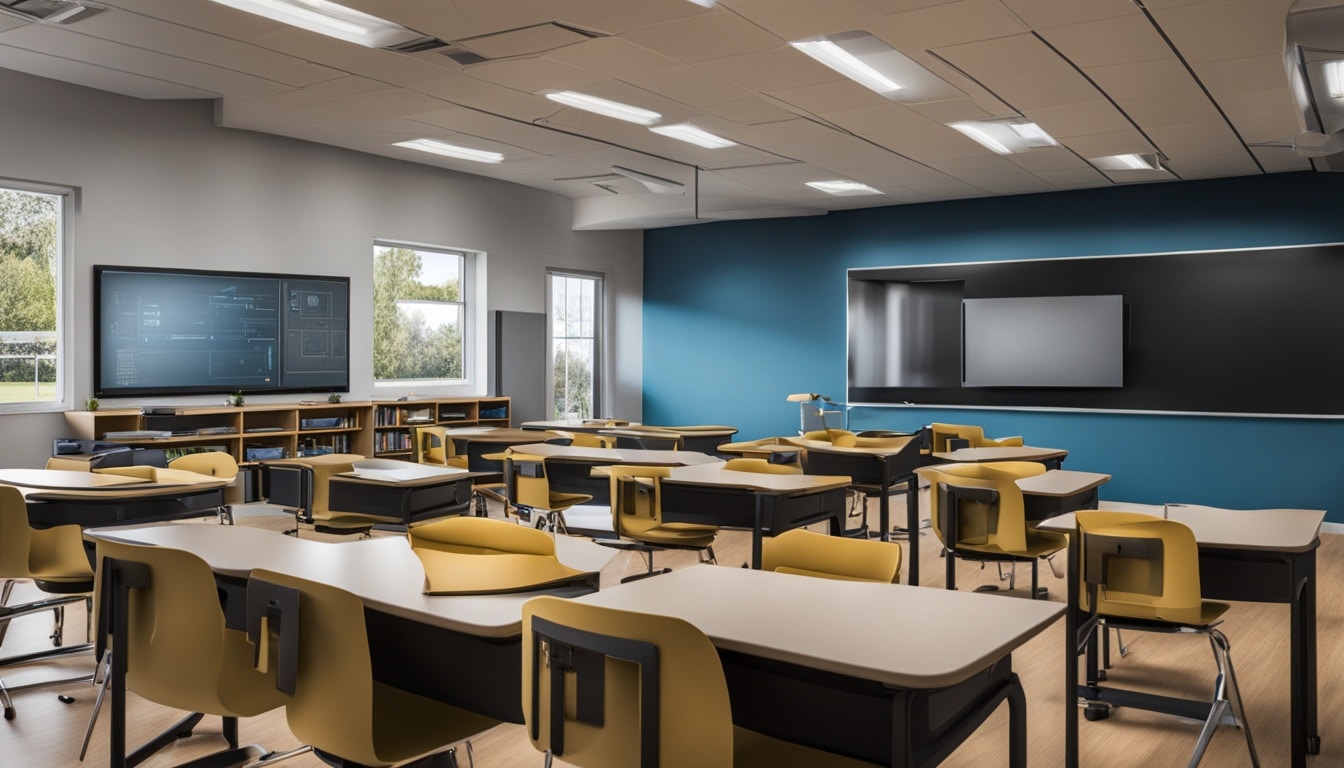Table of Contents
ToggleThe world is changing fast, and this affects how we learn to succeed. For years, education meant lots of time in classrooms. But now, new knowledge replaces old fast. This shift calls for a rethinking of how we learn.
New education trends are emerging, readying students for modern challenges. Technologies like artificial intelligence are making their way into teaching. Moreover, learning via the internet or a mix of online and in-person has become more common. These changes aim to equip students for the jobs of the future.
Key Takeaways
- Formal education is adapting to the rapid pace of technological and societal change.
- Artificial intelligence is reshaping the classroom experience, from virtual assistants to personalized tutoring systems.
- Remote, online, and hybrid learning models are becoming increasingly prevalent, driven by the COVID-19 pandemic and the need for flexibility.
- Vocational and technical skill development are gaining prominence as alternatives to traditional college pathways.
- Virtual and augmented reality are being integrated into formal education to create immersive learning experiences.
Artificial Intelligence in Formal Education
Artificial Intelligence (AI) is changing industries and activities worldwide, including education. It’s seen in virtual assistants and tutoring systems in classrooms. These tools support both students and teachers, managing time and improving learning.
AI-Powered Virtual Assistants and Tutoring Systems
AI-powered virtual assistants are reshaping education. They help with schedules and give advice. They also support with research and writing, letting students engage in deeper learning.
At the same time, AI-driven tutoring systems analyze student progress. They then offer lessons and exercises tailored to their needs. This personalization helps students reach their learning goals.
Facial Recognition Technology to Monitor Student Attention
AI is also using facial recognition technology to check student focus in class. It reads facial expressions and body language to see how well students understand. This allows teachers to adjust their lessons to help everyone learn better.
This tool is valuable in identifying students who are struggling. Early intervention with teaching can make a big difference for these students.
Addressing Inequalities and Access to Knowledge
But, using AI in education raises concerns about fairness and access. Making AI-powered educational tools available to all students is crucial. It doesn’t matter their background or learning style, every student should benefit equally.
By using AI right and with ethics in mind, schools can offer personalized education to every student. This approach enhances the learning experience for all.
Also Read : What Are The Best Remote Work Opportunities Available Today?
Formal Education: Remote, Online, and Hybrid Learning

The global COVID-19 pandemic made schools and colleges quickly shift to remote learning education and online learning education. This change came fast but was part of a growing trend. Even before, online learning education was gaining traction, especially massive open online courses (MOOCs).
Massive Open Online Courses (MOOCs)
MOOCs changed education by offering top courses freely online. Learners worldwide could join without normal school requirements or paying fees. This way, they could enjoy learning key skills or from famous experts at their own pace.
Online Education Technology Platforms
New tech brought us hybrid learning education on online education platforms. These platforms use AI, smart learning systems, and data to help students learn better and faster. It’s making education more personalized and impactful worldwide.
Celebrity and Renowned Practitioner-led Courses
Now, digital learning offers classes from experts, the celebrity courses education and practitioner courses education. These courses help students and professionals gain unique skills and knowledge. This could really boost their careers and personal advancement, beyond regular education.
Also Read : IT Jobs Part Time: What Skills Are Needed For IT Jobs?
Preparing for Paths Beyond Traditional College

High schools are changing how they prepare students for their futures. They’re focusing on a wider range of career options, not just the usual four-year college route. Many students learn better outside the usual classroom setup. They’re finding success in careers that don’t require a college degree.
Vocational and Technical Skill Development
Schools are offering more vocational education and technical education programs. These help students learn practical skills in fields like car repair, web design, and more. Partnerships with local companies help schools teach what’s really needed in the workforce. This way, students are ready to work as soon as they graduate.
Apprenticeships and On-the-Job Training
More and more schools are starting to offer apprenticeships education and on-the-job training education. These let students get real work experience and learn on the job. It’s a great way for students to learn, and they get paid while they do it. Companies also like these programs because they can train future workers their way.
High schools are giving students more choices in their education. These options help young people find what’s best for them based on their interests and skills. This way, students are well-prepared for whatever the job market of the future looks like.
Also Read : Remote Working Jobs: What Skills Are Most Valuable In Remote Work?
Virtual and Augmented Reality in Formal Education
Virtual reality (VR) and augmented reality (AR) are changing how we learn. They make learning more interesting by taking students to different places and times. This makes understanding and remembering lessons easier.
Virtual Classrooms and Immersive Learning Experiences
With VR, students can visit anywhere in the world from their classroom. They can explore ancient ruins, witness scientific events, and practice hands-on tasks in a safe, virtual space. This immersive experience makes learning real and memorable.
Teachers are using VR in many ways. For example, they’re taking students on virtual field trips and using lab simulations. This interactive learning method keeps students engaged and eager to learn more.
AR Textbooks and Interactive Exhibits
AR is also changing how we learn, with AR textbooks and exhibits becoming popular. These tools add digital elements like 3D models and animations to physical books. This makes learning more fun and interactive.
Now, students can see complex structures, observe chemical reactions, and interact with lessons in exciting ways. It helps them understand and remember what they learn better.
VR and AR are making learning more immersive and personal. As these technologies get better, they will become even more important in education. They will let students learn in ways they never could before.
Also Read : Education Degree Online: What Are The Admission Requirements?
Soft Skills and STEM in Formal Education

The world is using more technology, making soft skills just as crucial in school. Skills like communication, teamwork, and creative thinking are needed for jobs. These skills are special to humans and can’t be replaced by machines. Employers value them in many fields.
At the same time, schools understand how important STEM (Science, Technology, Engineering, and Mathematics) is. With technology moving fast, students need a strong STEM base for the future. By combining STEM education with soft skills, schools help students grow in all areas. This prepares them well for their careers.
Now, with AI doing many technical tasks, soft skills are even more essential. Companies want employees who can think clearly, talk well, and work together. Schools are working to make sure students have both technical and human skills. This way, they’re ready for the job world.
By balancing soft skills education and STEM education, schools get students ready for any job. This complete learning method lets people reach their full potential. They become valuable future workers.
Also Read : Special Education: How Can Parents Get Help For Their Child?
Formal Education: Embracing Technology and Lifelong Learning
The world is changing fast, and so is the way we learn. Formal education systems are using more technology and encouraging lifelong learning. This helps students and workers keep up with the fast-changing world.
Adapting to the Fast-Changing World
Change in the world is happening quicker and in more surprising ways. Formal education is using new ways to prepare people for future challenges. It uses technologies like artificial intelligence and virtual reality for better learning. This way, students learn skills like critical thinking and problem-solving needed to do well despite changes.
Micro-Learning and Nano-Learning
The way formal education works can sometimes fall behind on what’s needed in the workplace. Micro-learning education and nano-learning education are new strategies that help. They let individuals learn new things a bit at a time, fitting into their day easily. This approach makes lifelong learning education easy and helps students and workers stay competitive.
Non-Traditional Learning Paths and Formal Education

Formal education once focused mainly on four-year colleges. Now, it values other ways people learn. Jobs change, needing specific skills. This encouraged more personal and easy paths to learning. Not everyone finds success in the usual classroom.
Community-Based Adult Education
Local non-traditional learning paths education are often more valuable to adults than mainstream options. They offer skills for jobs, ways to grow personally, and career help. These programs work closely with community groups to make learning easier and more helpful for adults. Their approach meets different needs well.
Professional and Vocational Training Programs
Professional Training education and vocational training education are popular paths today. They focus on skills that jobs need. Places that teach these skills are either like schools or specific to certain industries. They offer things like apprenticeships, giving learners what they need to succeed in special fields.
| Program Type | Focus | Outcomes |
|---|---|---|
| Community-Based Adult Education | Practical skills, career development, personal enrichment | Flexible, accessible, tailored educational experiences for diverse adult populations |
| Professional Training Programs | Job-ready skills, practical expertise | Technical certifications, industry-specific knowledge and competencies |
| Vocational Training Programs | Specialized, hands-on skills | Preparation for careers in skilled trades and technical fields |
The Role of Formal Education in Skill Development
The job market is changing, and education helps people keep up. It focuses on fixing the skills gap. This gap means employers can’t find workers with the right skills.
Addressing the Skills Gap
Teachers and schools are making changes. They’re updating what they teach to meet what employers need. Formal education skill development now means learning both job-specific and people skills.
Collaboration with Employers
Schools are talking more with companies to keep up-to-date. Together, they make programs that teach students exactly what they’ll need in the workforce.
This way, students get real-world experience before they even graduate.
This link between schools and workplaces helps close the skills gap. It makes sure students leave school ready for their careers.
Also Read: What Are The Key Benefits of Integrating Education Technology?
Conclusion
Education is changing a lot because of quick tech and social changes. As conclusion formal education trends show, schools are trying new ways to teach. They want to make sure students are ready for the fast world we live in.
New things, like AI and virtual reality, are being used in schools. They’re also focusing more on skills like teamwork and always learning. This is to help students succeed in a world that keeps changing. The conclusion formal education trends say it’s also key to work with companies. This way, schools can offer training that really helps people get good jobs.
Our schools are changing to meet everyone’s needs better. The conclusion formal education trends point out the importance of being flexible. By keeping up with what students, employers, and society need, schools can help a lot. They can make sure everyone is ready for their future. This is how we all get a chance to do well in the coming years.
FAQs
Q: What is formal education?
A: Formal education refers to the structured learning process that takes place within an educational system, typically starting from primary school up to higher levels of education like secondary school and beyond.
Q: What are the differences between formal and informal education?
A: Formal education involves a structured curriculum and is usually provided by certified teachers within an educational institution, while informal education is more spontaneous, unstructured, and can occur in any setting through daily life experiences.
Q: What are the three types of education?
A: The three types of education are formal, informal, and non-formal education. Formal education is classroom-based, informal education is experiential learning gained through life experiences, and non-formal education is structured but not part of the formal system.
Q: Why is formal education important?
A: Formal education is important because it provides individuals with essential knowledge, skills, and abilities needed to succeed in various aspects of life. It also helps in personal development and prepares individuals for future career opportunities.
Q: How does formal and informal learning differ?
A: Formal learning follows a structured curriculum designed by educational institutions, while informal learning occurs spontaneously without a set curriculum and can happen anywhere, at any time.
Q: What is non-formal education?
A: Non-formal education refers to structured learning that is not part of the formal education system. It includes activities such as adult education courses, professional development workshops, and skill-building programs.
Q: Can you provide examples of formal education?
A: Examples of formal education include attending primary and secondary schools, universities, colleges, vocational training programs, and other certified educational institutions.





